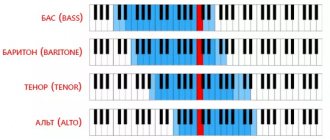Currently, there are many classifications of singing voices. In some cases, only the strength of the voice is determined. This refers to how loud the singer can perform the pieces. And others - how mobile his vocal cords are.
But in most cases, the performer’s range and gender are still taken into account. Female and male voices are divided into their specific divisions.
Female voices are: soprano, that is, the highest, mezzo-soprano - middle, contralto - low. Male voices: tenor is the highest, baritone is medium, bass is low. But there are also many male singers who have female vocal ranges. Each of them sounds especially amazing.
We present to your attention a list of the 10 highest female and male voices in the world: unique timbre and playing any notes.
Anna Netrebko
Anna Netrebko
known throughout the world , is an opera singer and People's Artist of the Russian Federation. The girl was awarded many times.
Anna was born in Krasnodar into a family of ordinary people. Father is a geologist, and mother is an engineer. From a very early age, the girl began to study music and singing. It is worth noting that she was initially a soloist of the Kuban Pioneer choir.
After winning the Glinka competition, she was invited to the theater, where she began to actively engage. At the beginning of her career, Anna had a lyric-coloratura soprano, but gradually, her voice evolved, and the girl achieved a lyric-dramatic soprano.
Anna Netrebko's career began after one audition, where she auditioned for the musical play “The Marriage of Figaro.” The screenwriter was so amazed by the girl’s voice that he immediately offered her the role. Since 1994, she has actively performed on stage.
Famous singers
A popular American tenor is Richard Croft. He has a lyric, or rather, Mozartian tenor. The Italian Alessandro Safina is slightly inferior to him in terms of vocal range.
But the most famous owners of high voices are the Spaniards Placido Domingo, Jose Carreras and the Italian Luciano Pavarotti, who made up the legendary opera trio “The Three Tenors”. With this lineup, the singers toured the world with concerts from 1990 to 2003.
Owners of tenors are also found in pop art. Among these are the well-known Chester Bennington from the group Linkin Park, Adam Levine from Maroon 5, Michael Jackson, Adam Lambert, Billy Ocean, Ryan Tedder from One Republic and many others. Of course, their vocal range is significantly inferior to the opera singers from the Three Tenors trio. Is it possible that the “golden voice of Russia” - Nikolai Baskov - can compare with them, since the singer came to the stage from opera, and therefore has not only excellent vocal abilities, but also several years of improving them for opera roles under his belt.
Svetlana Feodulova
Svetlana Feodulova is one of the famous singers and actresses of our time. This girl is quite unique in her own way. She performs works in the fourth octave. This is quite rare in nature.
As a teenager, her voice broke a lot, and many teachers considered the girl unsuitable for singing and playing music. But Sveta did not give up, but continued her musical path. She believed that everything would work out. This is how she became the owner of a high voice.
It is worth noting that in 2010, Svetlana was included in the Guinness Book of Records. Fame came to her after she took part in one famous project “Voice 2”.
Svetlana Feodulova’s vocal abilities were appreciated not only here in Russia, but also abroad. Currently, she is actively building her career as an opera singer.
Female singing voices
The highest of women's voices and voices in general is the soprano. His vocal range is from the first to the third octave, from the note C4 to A5 (in choral singing) or to C6 (in operatic singing). According to Russian musical tradition, the soprano is divided into:
- dramatic (powerful voice with a rich middle register); - lyrical-dramatic (intermediate type of voice); - lyrical (voice with a soft timbre, notes of the second octave work best); - lyric-coloratura (head notes are highlighted); - coloratura (the highest voice capable of performing leaps, arpeggios, scale-like passages, etc.).
Classic operatic soprano roles include the part of Isolde in the opera “Tristan and Isolde” by R. Wagner, Cleopatra from “Julius Caesar in Egypt” by G. F. Handel , Lyudmila from “Ruslan and Lyudmila” by M. I. Glinka , Tatyana from “Eugene” Onegin" by P. I. Tchaikovsky .
Article on the topic
The main thing is practice.
5 steps to a beautiful voice The next highest female voice is the mezzo-soprano. Its operating range is within A3-A5. This voice is distinguished by its richness and fullness of sound in the “middle”, as well as the softness and volume of the sound of chest notes. In the Russian musical tradition, the mezzo-soprano timbre is noticeably different from the central and high sopranos; it is characterized by a rich, deep sound, a little ponderous. In turn, mezzo-soprano is also divided into dramatic, lyric and coloratura. Classic examples of mezzo-soprano parts are the part of Cinderella from the opera of the same name by G. Rossini , Carmen from the opera of the same name by G. Bizet , Margarita from “The Damnation of Faust” G. Berlioz , Marina Mnishek from “Boris Godunov” by M. P. Mussorgsky .
Contralto is the lowest of female singing voices, with a wide range of chest register. Contralto vocal range is F3/G3—F5/G5. This voice is distinguished by thick, rich notes in the second octave. Unlike mezzo-soprano and soprano, contralto can voice all notes of the small octave. Contralto owners are best at performing low notes. In opera for contralto, composers often wrote the parts of young boys. Opera examples of contralto include the part of Vanya from “Ivan Susanin” by M. I. Glinka, Olga from “Eugene Onegin” by P. I. Tchaikovsky, Orpheus from “Orpheus and Eurydice” by K. V. Gluck .
Anna German
Almost every person knows Anna German . The singer had Polish roots. She could easily perform works in different languages. She has been a laureate of international festivals many times.
The girl's vocal career began for the first time in 1960. Then she found herself on the stage of the student theater, where she was invited by the director of this project.
Many composers wrote their songs for Anna. Such famous personalities were Evgeny Ptichkin, Alexandra Pakhmutova, Vladimir Shainsky and many others.
Many said that Anna has an “angelic” voice. By nature she was a soprano, but with a transparent, unusual timbre. Her manner of performing works gave the impression that there were no restrictions on voice register.
Classification
There is a classification of this voice, which involves dividing the tenor according to its timbre and range. In this regard, it is customary to distinguish:
- lyrical;
- dramatic;
- baritone tenor;
- counter-tenor;
- altino-tenor.
Let's look at each type of named male voice separately.
Galina Vishnevskaya
Galina Vishnevskaya is a Soviet opera singer with a soprano voice. People's Artist of the USSR, as well as a teacher and theater director.
Galina had one of the rarest combinations of voice, beauty and a wonderful, bright character. Her whole life is actions. Already from her youth, she actively worked on stage. Vishnevskaya gave people a lot of joy and incredible emotions. Her voice was recognized everywhere. Everything was perfectly combined in it.
Galina taught vocals for a very long time. She tried to put her whole soul into her students. Until the end of her life she was thanked for this.
Bass
Low, deep, strong, bewitching voice. The range can range from E-F of the major octave to F-sharp of the first octave. Bass varies both in pitch and timbre. There is a high bass cantanto, and the lowest bass is profundo; it can be used in choirs even up to the counteroctave. In terms of timbre, along with the deep profundo bass, comic bass and bass buffo are also distinguished.
Article on the topic
Fyodor Chaliapin: little-known facts and milestones of creativity The most famous bass in the world is
Fyodor Chaliapin . Evgeny Nesterenko , who, unfortunately, does not sing on stage now,
has also become widely famous The bass is an extremely expressive and rich voice; unfortunately, there are not many singers, as well as parts. The roles of Bartolo in “The Barber of Seville” by Rossini, Kochubey from “Mazepa” by Tchaikovsky, and Ruslan in M. Glinka’s opera “Ruslan and Lyudmila” were written for bass
Mephistopheles' aria from the opera "Faust" by Charles Gounod, performed by Fyodor Chaliapin
Ivan Kozlovsky
Ivan Semenovich Kozlovsky
had a unique tenor in the world . This man was even respected by Stalin himself. Many called him a “man of mystery.”
He lived quite a long life. During his life, he saw many ups and downs. At the age of 17, Ivan came to the Music and Drama Institute, where he was immediately sure that he would definitely be accepted. After auditioning, he took part in various productions many times.
At the Bolshoi Theater he became one of the most famous personalities. The man could easily hit the highest notes without any effort. Kozlovsky himself said that he was very careful about his voice, he took care of it as a separate being.
How to control the timbre and pitch of your voice
So, how do you control the timbre and pitch of your voice? As you understand from the above experiments and studies, almost every person can slightly raise or slightly lower the pitch of their voice, even without special training in voice production. Various psychological factors can also influence in such a way that a person begins to speak more quietly or higher.
Since the tonality and timbre of the voice, in principle, can be influenced, why not take this fact into account and try to influence the voice consciously and meaningfully? And not just a little bit, but as much as we need to achieve a beautiful timbre... The idea is tempting and, most importantly, completely realistic for implementation within reasonable limits!
What does “within reasonable limits” mean? This means that you should not try to drive your voice to a height at which it cannot sound fully, with the participation of the necessary resonators. If you want to get a subtle and sonorous timbre, but you naturally have large and not very mobile vocal cords, and at the same time you have not worked on connecting the resonators, then you can only hit high notes in the head resonator.
A voice that is formed exclusively “in the head” without the participation of the chest resonator will be either weak and squeaky, or breathless and unintelligible, or shrill, or even simply break.
If you want to speak in a low, velvety voice, but you have a naturally metallic tenor, then the lower range without training the connection of the resonators will either be creaky, or hoarse, or you will lose your voice altogether.
In addition, to make your voice (any voice!) sound beautiful and convincing, you should always remember to breathe deeply into the lower part of your lungs . This type of breathing is also called diaphragmatic or diaphragmatic breathing.
You should also remember about diction and articulation , which should be sufficient, but should not be redundant. So, if you barely open your mouth and don’t use your articulatory muscles, the sound will get stuck in your mouth and you won’t get a full sound. If there is too much articulation and you open your mouth too wide where it is not needed, the sound will be rough.
We studied all these aspects of working with the voice - breathing, support for sound, diction, articulation, connecting resonators - in lesson 2. This is the basic knowledge for setting the gloss, which we have already needed more than once and will need in the following lessons too. Therefore, if something remains unclear, read and work through the material in Lesson 2 again.
In principle, in order to skillfully control the pitch of your own voice, you need to remember and put into practice two important points :
- For a beautiful high voice you need both head and chest resonators. The head resonator provides access to high sounds, and the chest resonator makes high notes more expressive and allows you to get rid of the squeaky sound in your voice, as if only the head resonator is working.
- A beautiful low voice also requires the joint work of all resonators. The chest resonator gives access to low notes, providing a powerful sounding voice at the bottom, and the resonance in the upper resonators provides lightness and flight of the voice.
In addition, do not forget that the oral resonator provides a more open, loud sound of the voice, helps remove tension from the throat, helps to speak more freely, and the nasal resonator acts as a connecting link for all resonators, giving clarity and clarity to the sound of each resonator and the voice as a whole.
Let us remind you once again that resonators are natural amplifiers of our voice inside our body. They allow you to make your voice higher or lower, louder or quieter, and enrich the color of the timbre. By learning to control the flow of air and direct it into a particular resonator, you can open up your voice in a new way and instantly change many of the characteristics of your voice that you learned about in the first part of the lesson.
Therefore, if you want to expand the range, work on the resonators , and over time you will be able to sound higher or lower than now. Moreover, when working on one or another part of the range, you can often observe some symmetry in the results. If you work on the higher notes and expanding your range upward, the lower notes begin to sound more confident and your working range expands not only upward, but also downward a little.
And one more important aspect. It was not for nothing that we began the practical part of the lesson with the topic of meaningfulness and awareness in working on timbre. The fact is that you can plan not only the content and structure of speech, pauses and logical stress, but also all aspects of sound production! We touched on this point briefly in previous lessons, but now is the time to continue.
In your mind and then out loud, you can rehearse not only the text of the future message, but also its emotional intensity, volume, pitch, and tempo. You can try to set one or another timbre and rehearse speech with different intonations. Knowledge of the anatomy of the voice gained in our course and an understanding of how certain movements and positions of the sound production organs affect your voice and your speech will help you with this.
An interesting point: the dictionary of associations offers about 70 possible definitions for the word “timbre” [Dictionary of Associations, 2020]. Therefore, if you find it difficult to figure out how to diversify your speech, such a selection of associations may well help you.
In addition, special exercises offered by French professor Philippe-Nicolas Melot, who teaches singing to professionals and amateurs, will help you develop a meaningful approach to sound science, learn to control pitch and change (within reason!) the timbre of your voice.
Exercises to control the timbre and pitch of your voice:
| 1 | Make an “earphone” and a “microphone” from your palms: place one palm to your ear, the other to your mouth, and start reading the text (counting crows, humming a song). This way you will hear your voice as close as possible to how others hear it, while maintaining mobility and the ability to immediately change something and try to adjust the pitch or timbre of your voice if you don’t like something. This is not instead of recording your voice on a voice recorder and monitoring the result. This is in addition to being able to quickly grasp the relationship between your voice guidance efforts and the result. |
| 2 | Exercise your facial muscles to take pressure off your throat and vocal cords and maximize use of your diaphragm and articulation. Pronounce the syllables “Q” and “X” one after another, but on “Q” your lips should round, and on “X” they should open into a wide smile. Repeat 30 times. If you try to tell something immediately after this, you will hear that the speech has become more intelligible and free. |
| 3 | Read texts (poems, stories, songs) aloud, artificially stretching the vowels. You can even just skip the consonants if it helps you focus on the vowels. This will help make your speech more melodic. By the way, Philippe-Nicolas Melot advises native French speakers to skip consonants and draw out vowels (remember that Philippe-Nicolas Melot is French). So if you are rehearsing a speech or song in French, draw out the vowels without the consonants. Now the same text needs to be read, minting and articulating consonants. This will make your speech more intelligible. |
| 4 | Now read the text with a sharp, angry intonation. Imagine that this anger comes from within you. To control sensations, you need to put your hands on your solar plexus. This will add richness to your sound. You can rehearse with other emotions. |
| 5 | Standing on the floor without shoes, breathe calmly, inflating your sides and stomach with air. Then begin to slowly shift your body weight from heel to toe and back. Continue swinging with your eyes closed, focusing your inner attention on your feet. This is so as not to lose your balance. Control only your feet - this way you will learn to distribute energy within yourself, use the energy and muscles of the body to better sound your speech. |
You can see how to do these exercises correctly in a specially prepared video:
The advice of Lillian Brown, a professor at Northeastern University in Boston (USA), will help you set the desired timbre for your voice and learn how to adjust its pitch depending on the situation. She addressed her advice to her English-speaking compatriots, but in a form adapted for a Russian-speaking audience, these recommendations are completely acceptable. She believes that no matter what kind of gloss a person has from birth, he can always improve it with practice [L. Brown, 2020].
Tips for improving your voice from Lillian Brown:
- Inhale deeply, using the diaphragm.
- Maintain an even posture so as not to compress the internal organs and allow the body to be fully saturated with oxygen.
- Distribute the weight evenly on your legs, straighten up to your full height, slightly moving your head back. In this position, you can control the speech apparatus in the best possible way.
- You can lower your voice if you speak “straight from your socks,” i.e. pressing your heels firmly into the floor. If you maintain an even posture, the diaphragm bends on its own, giving the air flow more space.
- Cover at least an octave with your voice, i.e. 4 notes above and 4 notes below your most comfortable middle note.
- Visually represent what you are talking about. This will make the speech more lively and emotional.
- Read aloud at least 10 minutes a day.
- Read aloud your text, which you are about to speak publicly, and refine the fragments that do not sound very good.
- Articulation should be clear, but mannered articulation should be avoided.
- Speak calmly and measuredly, without rushing. You can slow down your speech by using clear articulation of words.
- Avoid filler words, long unreasonable pauses and interjections in speech.
- Be sure to rehearse the pronunciation of difficult and unfamiliar words before speaking them in public.
And, of course, the timbre of the voice and the ability to sing higher and lower are of great importance for vocalists . In our course, a separate lesson is devoted to vocals, but you can start training now. You remember that the head resonator is responsible for accessing high notes, and we sing low notes using the chest resonator. Therefore, it is worth additional work on the chest and head resonators.
Tips for beginners on how to cope with high notes:
- Try opening your mouth wider. For beginners, this is usually a big problem due to either lack of skill or forgetfulness. Therefore, control the width of your mouth opening as you approach high notes. If necessary, work through the exercise from Lesson 2 on opening your mouth with 2 fingers again.
- Try squatting slightly or leaning forward a little when approaching high notes, as many pop singers do. In the lesson dedicated to vocals, we will focus on such a concept as anchoring (from English anchor - anchor), i.e. the use of body muscles to support (anchor) the sound flow. For now, just remember that you can use your body to help you reach those high notes.
- Use your imagination and imagine that you are singing “into yourself”, maintaining support for your voice and not letting air out. Develop your success and try to “breathe” your voice into yourself.
- Imagine that there is a candle flame in front of you, and you need to sing so as not to blow out the candle.
- Add a meowing or whining intonation to your voice. If you carefully and completely watched video lesson No. 3, given by Russian singer Polina Gagarina as part of the “Generation M” charity project, you already know that natural sounds – crying and moaning – contribute to the opening of resonators.
More courageous crying, as well as other exercises, was demonstrated in his video by singer, musician, author of a blog dedicated to vocals, Ivan Radkov:
By the way, pay attention that when they show you on video how to open your mouth, the singer’s tongue lies flat, and the tip of the tongue is located at the lower teeth. Don't forget to repeat (and apply!) the material from previous lessons in practice. And remember that each new topic is not a reason to forget what you have learned previously. If you succeeded in the exercises from the previous video, you can try more complex exercises:
Similar thoughts and, in addition to this, tips on how to remove clamps from your voice can be found in the singer, blogger and vocal coach Alexandra Stroitseva. Please note that you need to treat your voice adequately and not demand from it those high notes and those shades of timbre that it does not yet have. Both notes and shades of sound are achieved through persistent training and conscious control over your voice:
It has long been known that owners of low voices dream of getting their hands on high notes, and owners of high voices almost always want to master the lower range. In fact, you can help both.
Tips for beginners on how to cope with low notes:
- Lower your larynx slightly. To feel the correct position, you should put your hand on the front of your neck and yawn with the sound “a-a”. The palm will feel the larynx going down. This is the desired position of the larynx.
- Maintain resonance in the nasal and head resonators, which is felt as resonance in the front part. In the lesson on vocals, we will tell you what a vocal mask is. For now, remember that on low notes the upper resonators also work, although not as intensely as on high notes.
- Practice singing with your larynx slightly lowered and a pencil held between your teeth. Don't strain your jaw! This will allow you to develop proper coordination between the larynx, facial muscles and jaw.
- Train the work of the chest resonator by placing your hand on your chest and placing your voice on a support. You need to pronounce something between “ge” and “he” (similar to the letter “g” in Ukrainian). You can practice on the syllable “gem-ma” or “hem-ma”.
And, of course, a video on this topic:
So, in this lesson we dealt with such characteristics of the voice as pitch and timbre, and understood how to influence these characteristics of our voice. If nasality interferes with the formation of a beautiful voice and timbre, here is a video for you on how to get rid of nasality in your voice:
All we have to do is consolidate the acquired knowledge with the help of a verification test and continue working on other characteristics of the voice in the next lesson.
Ima Sumac
Ima Sumac is a singer whose voice rose to 4 octaves. A girl was born in a small village. It is worth noting that Sumak did not have any musical education at all; her voice was given to her by nature.
One day, after one of her performances, she charmed all the listeners with her voice. Success came to her quite quickly, she successfully toured in many cities. Ima herself said that she tried to imitate the sounds of nature, the singing of birds in the forest. She was able to easily move from low tones to higher ones.
Baritone
Average male voice, range from A major octave to the middle of the first octave. This voice is strong, rich, velvety, it can be softer and more mobile, it can be close to a tenor, in which case it is called a tenor-baritone. If a baritone is stronger on low notes, but has fairly free upper notes, then it is more of a bass-baritone. Like other voices, there are also lyrical and dramatic varieties of this voice.
Perhaps the most famous baritone in the world is Dmitry Hvorostovsky , in Moscow it makes sense to listen to Vasily Ladyuk from the New Opera.
There are a lot of parts for baritone; composers often entrust them with the most important characters in the work. For example, Mozart’s Don Juan, Mizgir in The Snow Maiden, and Tchaikovsky’s Mazepa were written for baritone.
Aria of Georges Germont from the opera La Traviata by G. Verdi, performed by Vasily Ladyuk
Luciano Pavarotti
Luciano Pavarotti could play notes in the second octave. In fact, this is the ultimate note for the chest sound. He perfectly performed parts with original C notes in many works, and did it brilliantly.
Hundreds of thousands of people came to his solo concerts. Once the audience was so amazed and captivated by Luciano's voice that the curtain had to be raised about 165 times.
Tenor
Male high singing voice. Its range is from the beginning of the minor to the beginning of the second octave. The ability to play the top notes is especially valued. If the highs are weak, then such a tenor is unlikely to become a famous soloist. Like female voices, like sopranos, tenors are divided into lyric and dramatic voices. There is also an altino tenor, which is distinguished by particularly high and sonorous notes.
There are a lot of famous and beautiful tenors. For example, Luciano Pavarotti (lyric tenor) or Placido Domingo (lyric-dramatic tenor).
A lot of parts have been written for tenors. Often the main character in Italian operas sings as a tenor. The Duke in Verdi's opera "Rigoletto", Faust in Gounod's opera of the same name, from the Russians: Lensky in "Eugene Onegin", Don Juan in Dargomyzhsky's "The Stone Guest".
The Duke's song from G. Verdi's opera “Rigoletto”. Performed by Alexander Bogdanov
Renee Fleming
Renee Fleming is a famous singer from Indiana. A girl was born into a musical family. After finishing school, she took on the roles of a soloist in various operas and performances. Her career began back in 1996, after she recorded a disc with a Mozart opera. She took part in festivals many times.
Her voice is a lyrical, gentle soprano. The audience was amazed by such incredible sound. It is worth noting that she performed many tracks from the film “The Lord of the Rings” personally.
Countertenor
A very rare voice. The highest of male operatic voices, ranging from the beginning of the small octave to (sometimes) the end of the second. The art of such singing was revived in the middle of the 20th century. And as a rule, countertenor singers perform parts written for castrati singers in the Baroque era (boys were subjected to castration surgery before their voices broke and they reached puberty, due to which their voices remained high, and they performed female parts in operas, and initially in sacred works, in choirs).
Examples of such roles can be cited both from baroque and modern opera; now the countertenor is becoming more and more popular, although it has not yet lost its exoticism, which shocks the audience. You can listen to Handel’s opera “Julius Caesar,” where the title role is written for a countertenor, or you can listen to the opera “Zurich 1916” by Christopher Butterfield, where V. I. Lenin sings as a countertenor.
Georgia Brown
Georgia Brown is a famous singer from Brazil, who was included in the Guinness Book of Records in two categories at once. She received one of them for the highest note that is possible to hit with a human voice, and the other for a wide range. The girl is able to cover 8 octaves at once, when an ordinary person is only capable of 1-2 octaves.
Initially, Georgia started with simple matinees at school and small festivals. At the age of 17, the girl began recording her own songs. Currently, she is 32 years old and has 7 albums and 17 singles with her best works.
Many note that the singer’s voice is a unique natural anomaly that is quite rare.
How does a teacher determine your voice type?
If we are talking about classes with a teacher, then we can put forward four criteria for determining the type of voice:
- Firstly, this is the timbre, which is the individual coloring of a person’s voice;
- Secondly, there is the range mentioned above;
- Thirdly, it is the key in which it is easier for a person to sing;
- Fourthly, this is tessitura - pitch load on the voice.
As a test, the teacher can start playing the lower and then the upper limit of the range, as well as its middle. The student's task is to try to repeat the notes. For example, he can repeat them while humming the sound “m”.
You can also determine your voice by the length of your vocal cords. The voice is higher if the chords are shorter. For a soprano, for example, the length of the chords is in the region of ten to twelve millimeters, and for a bass it is twenty-three to twenty-four millimeters.
What can affect the timbre
There are several factors that can change the timbre of a person’s voice spontaneously. These include:
- puberty (a person’s tone changes as a result of growing up, becoming stronger, rougher; it is impossible to stop this process, the sound will no longer be the same as it was at an early age);
- colds, hypothermia (for example, when you have a cold, your throat may hurt and a cough may appear, the tone during this period changes, it becomes more hoarse, dull, and low voices predominate during a cold);
- chronic lack of sleep, emotional stress;
- smoking (with prolonged smoking, the timbre of the voice gradually becomes lower, rougher);
- chronic alcohol consumption (alcohol irritates the vocal cords and transforms the voice into a low and hoarse voice).
Almost all factors can be eliminated. That is why it is better to give up bad habits, try to avoid stress and not smoke in order to keep the tone of speech as pure as it is initially.
What is timbre, what does it depend on?
To determine this characteristic of your voice, you first need to understand in general what timbre is. This term refers to how and to what extent the voice is colored in the process of speaking or singing, its individual characteristics, as well as the warmth of the pronounced sound.
The leading tone and overtone (the specific shade of the leading tone) determine the sound of the voice as a whole. If the overtones are saturated (bright), the spoken sound will have the same qualities. The interaction of tone and corresponding overtone is an exclusively individual vocal characteristic, so it is very difficult to meet two people with the same tones.
The tone of the vocal or voice in ordinary speech is determined by the following qualities:
- anatomical shape of the trachea;
- trachea size;
- volume of the resonator (resonator - cavities in the human body responsible for amplifying sound - oral and nasal cavities, as well as the throat);
- the tightness of the closure of the vocal cords.
The psychological state, like all these anatomical characteristics, determines what kind of voice sounds at a given moment in time. That is why the timbre can be used to judge a person’s condition, as well as his well-being. This characteristic is not constant - a person can change his tone arbitrarily.
The following factors can also affect the timbre of your voice:
- human posture;
- speed of word pronunciation;
- fatigue.
The tone becomes less clear if the speaker is tired or pronounces all the words very quickly. With a crooked posture, a person also breathes incorrectly. Breathing determines how speech will sound, so posture cannot but affect the timbre of your voice.











